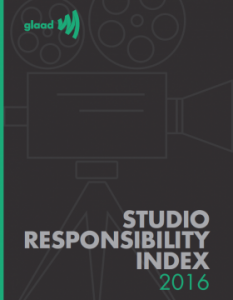 NEW YORK, NY – GLAAD today released its fourth annual Studio Responsibility Index (SRI), a report that maps the quantity, quality, and diversity of LGBT people in films released by the seven largest motion picture studios and their subsidiaries during the 2015 calendar year.
NEW YORK, NY – GLAAD today released its fourth annual Studio Responsibility Index (SRI), a report that maps the quantity, quality, and diversity of LGBT people in films released by the seven largest motion picture studios and their subsidiaries during the 2015 calendar year.
GLAAD found that of the 126 releases from major studios in 2015, only 22 of them (17.5%) included characters identified as LGBT. This marks no change from the 17.5% of films in 2014 with LGBT characters. More than three quarters of inclusive films (77%) featured gay male characters, less than a quarter (23%) included lesbian characters, and less than a tenth (9%) included bisexual characters. There was only one trans-inclusive film among all releases by major studios.
“Hollywood’s films lag far behind any other form of media when it comes to portrayals of LGBT characters,” said Sarah Kate Ellis, GLAAD President & CEO. “Too often, the few LGBT characters that make it to the big screen are the target of a punchline or token characters. The film industry must embrace new and inclusive stories if it wants to remain competitive and relevant.”
GLAAD also found that racial diversity among LGBT characters in film dropped drastically year over year. In 2015, 25.5% of LGBT characters were people of color, compared to 32.1% in 2014. Of the LGBT characters counted in 2015, 34 (72.3%) were White, 5 were Latino/a (10.6%), 4 were Black/African American (8.5%), and 3 (6.4%) were Asian/Pacific Islander.
No studios received a rating of “Good” for their 2015 releases. 20th Century Fox, Lionsgate Entertainment, Sony Columbia Pictures, and Universal Pictures all received ratings of “Adequate”, while Paramount Pictures, Walt Disney Studios, and Warner Brothers all received a “Failing” grade for their portrayals of LGBT people. Beginning next year, GLAAD’s SRI will implement a new grading system to more accurately report on LGBT representation in Hollywood. Instead of a four grade system, GLAAD will implement a five star scale from one star (“Failing”) to five stars (“Excellent”).
GLAAD observations and recommendations:
- The majority of LGBT characters in mainstream films remain minor – both in substance and screen time. Of the 22 LGBT-inclusive films, almost three quarters (73%) of them include less than ten minutes of screen time for LGBT characters. Not only must there be a larger number of LGBT roles, but they must be roles built with substance and purpose.
- LGBT portrayals on film are overwhelming White (72.3%) and male (77%). Films must do better to include LGBT characters in roles directly tied to the plot which reflect the wide diversity of our community.
- Transgender representation is shockingly low with only one character in the mainstream releases of 2015 – whose brief appearance served as a punchline to laugh at when her identity is revealed. Filmmakers should examine what message they are really sending when they rely on thoughtless humor to exploit an already marginalized community.
- 2015 saw a notable resurgence of outright offensive depictions of LGBT people, relying on gay panic and defamatory stereotypes for cheap laughs. Humor can be a powerful tool for holding a mirror up to society and challenging the norm, but when crafted without thought, it has the opposite effect and bolsters ignorance and prejudice.
In 2012, GLAAD introduced the “Vito Russo Test”, a set of criteria analyzing how LGBT characters are represented in a fictional work, in the first SRI and continues to judge films by these simple guidelines. Named after GLAAD co-founder and celebrated film historian Vito Russo, and partly inspired by the “Bechdel Test,” these criteria represent a standard GLAAD would like to see a greater number of mainstream Hollywood films reach in the future.
The Vito Russo Test criteria:
- The film contains a character that is identifiably lesbian, gay, bisexual, and/or transgender (LGBT).
- That character must not be solely or predominantly defined by their sexual orientation or gender identity (i.e. the character is comprised of the same sort of unique character traits commonly used to differentiate straight characters from one another).
- The LGBT character must be tied into the plot in such a way that their removal would have a significant effect. Meaning they are not there to simply provide colorful commentary, paint urban authenticity, or (perhaps most commonly) set up a punchline. The character should matter.
Only 8 of the 22 (36%) major studio films that featured an LGBT character passed the Vito Russo Test in 2015, the lowest percentage in this study’s history.
In 2015, GLAAD debuted a video titled “Hollywood Must Do Better” that highlighted a bevy of anti-LGBT moments in Hollywood films over the last five years. Additionally, GLAAD’s Where We Are on TV report, which forecasts the expected presence of LGBT characters for the upcoming television, will be issued later this year.











